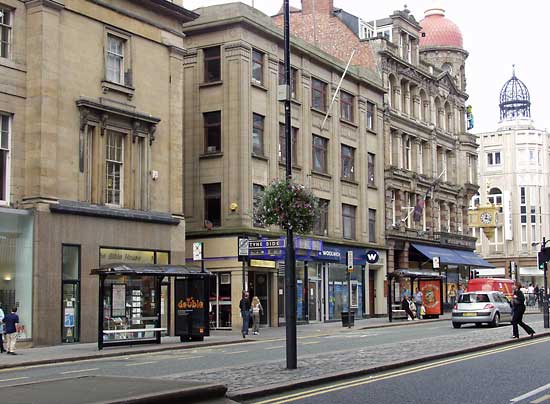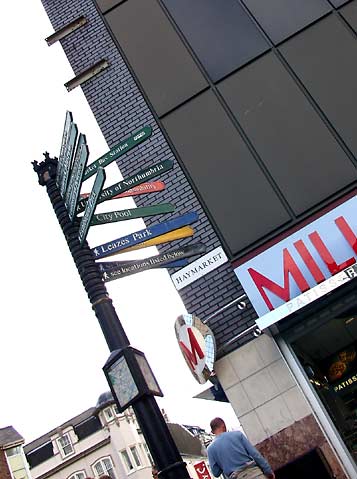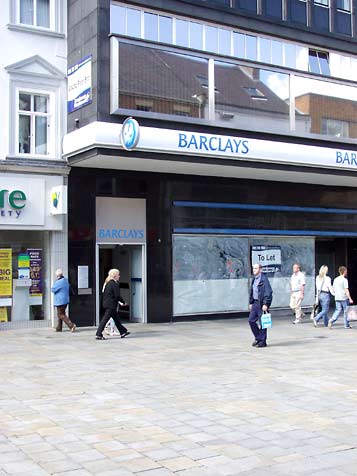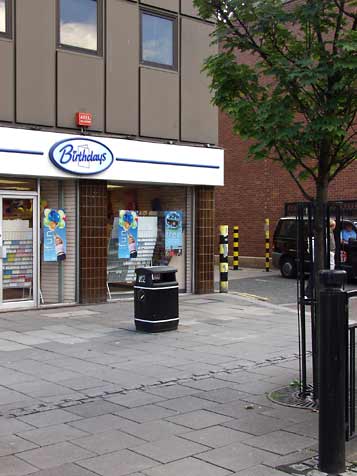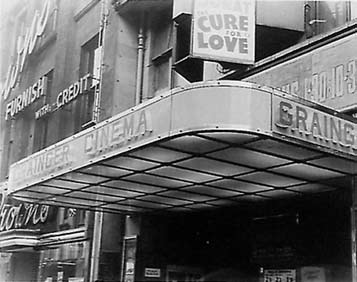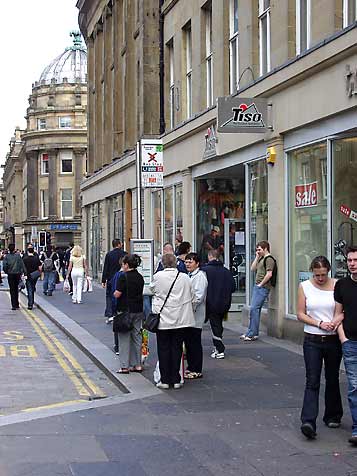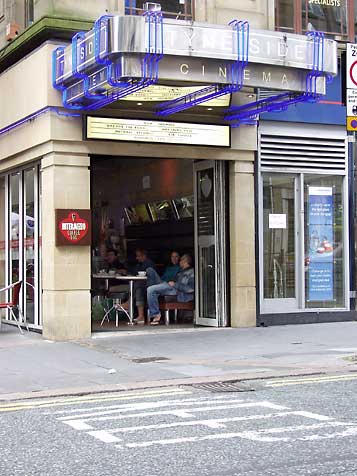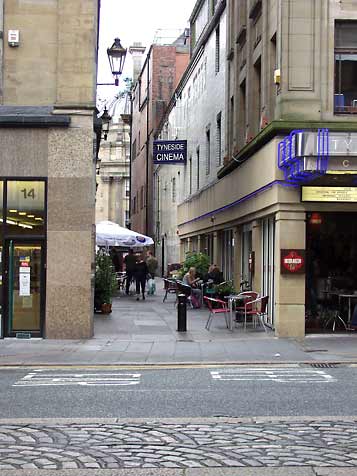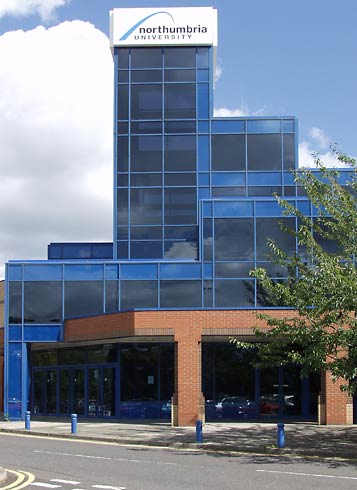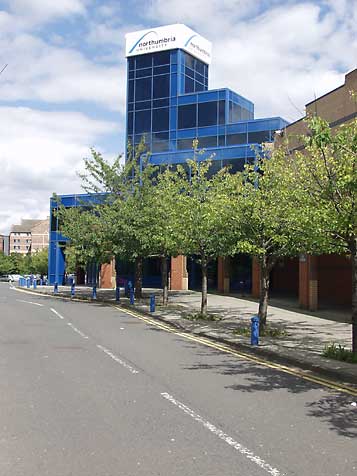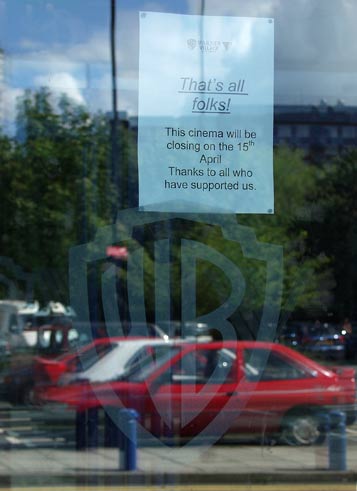|
It's News to Me
Sat. 21st Aug., 2004
|
 |
 |
|
The Haymarket will soon be all change as the Metro station receives a rebuild, but in
1937 it was the location for one of three News Theatres to be opened that year.
The idea of presenting news in central cinemas was not new, but it was late arriving in Newcastle. Shoppers
could pop in and see the rolling programmes of cartoons, short features and the latest newsreel.
The Tatler News Cinema was converted from Louis Bertorelli's cafe with its Northumberland Street
main entrance and extending through the block with another door in The Haymarket adjacent to the busy bus station.
|
|
|
 |
 |
 |
|
©1991 Newcastle City Libraries
|
|
|
|
The upstairs was kept as the Coffee Rooms, complete with grand piano, and the main auditorium was fitted out for 437 seats and decorated by my father in a restrained modernist
style. The colour scheme was predominantly rose with cream and silver reliefs with uplighters atop grooved pilasters. The curtain was cream heavy satin with a heavy gold satin border.
In the
cafe, served by a separate entrance, the decor was slate and magnolia with red and black soft furnishings.
Above is the 1938 view and opposite is the same scene today. Below is the site of the
Haymarket entrance. Since its closure in 1980 the building was remodelled.
|
|
|
|
|
 |
 |
|
During the 1950s The Tatler ran more cartoons that other news theatres but that did not stop the Classic takeover in 1964. By the end of that decade the news cinema was dead,
killed by the tiny television. In 1970 the renamed Classic Cinema Club catered for members only and showed thinly disguised programmes of mild porn and striptease.
In 1979, suffering failing
trade, it was taken over by Lord Grade and reopened to the public. This was a manifest failure and it finally closed on 24th August, 1980. The building was carved up for Barclays Bank and Halfords on the
Northumberland Street side, although the latter has closed within the last year and the site is now vacant.
|
|
 |
 |
|
The Grainger entrance was in the space between the two left pillars above and its auditorium ran from left to right behind. That shop entrance was Dunn's Gents Outfitters,
extending for six premises to the south. The shop next to the cinema was shallow, allowing for the auditorium behind.
The Grainger opened in 1913, pioneering the Edison sound disc system. Decor
was Classical with three roof domes, columns, and figures on the side walls, with a gross sculpture atop the proscenium.
Ownership passed first to George Black and then to the ABC chain. Sound
came at New Year 1926. Closure loomed when ABC enlarged its flagship venue in the Haymarket
1937 saw remodelling. Out went the Classical statues and columns, improving sight lines, and surfaces
were flattened. Concealed twin vertical lights adorned each side wall, decorated in an understated Art Deco beige, cream and orange. It boasted 515 stalls and 218 circle seats and it reopened as The
Grainger News Theatre in December.
Normal cinema programmes returned the following year and final closure came in March 1960, taken over by Dunn's Outfitters.
|
|
|
 |
|
©1991 Newcastle City Libraries
|
|
|
 |
The first of the three News theatres to open in 1937 is still open today. The News Theatre was purpose built in Pilgrim Street defiantly opposite the massive Paramount, later
Odeon, opened six years earlier.
It is on three layers. The arcade and foyer led down a short flight to the main auditorium decorated in the Deco style in sumptuous reds, browns and gold seating
412. A flight up the central square staircase led to the Coffee Rooms, still a restaurant, and a further flight to the smaller private plainly decorated cinema.
The main projection booth was
provided with room for the anticipated BBC TV cinema feed that sadly never happened.
|
|
|
As well as regular 35mm projectors, 16mm gear was installed and local amateurs were invited to show their films. This facility continues today, but confined to the upstairs
studio cinema.
Newsreel production finally ceased with the end of EMI's Pathe Pictorial and Rank's Look at Life in 1969. The News Theatre closed in March 1968, but renamed The Tyneside Film
Theatre, reopened supported by The British Film Institute under the directorship of Nina Hibbin, showing art, foreign and off mainstream films and a smaller club venue.
It is now renamed the
Tyneside Cinema, and the entrance arcade serves as a pavement coffee shop. It still thrives in its quirky selection and preserved 1930s decor.
|
|
|
|
|
 |
The modern version of the pop in at any time cinema is the multiplex, here, until recently, provided by Warner.
In 1988 Local businessman Joe Robertson suggested a
multiplex cinema as part of a leisure complex on the defunct railway yard at Manors, just to the east of the Central Motorway. The Tyne & Wear Development Corporation had other ideas for the site,
but were overruled by the local Council and the region's second multiplex (the first was at the Metrocentre) opened in 1989 with 9 screens and space for around 4,000 patrons. Warners brought the latest
technology with a single computerised projection room serving the whole complex and Dolby Stereo Spectral Sound.
|
|
|
The larger auditoria were provided with soundproof chambers for noisy children with windows and sound repeaters so as not to miss the film.
The building had at its
centre a large atrium with island booking station, a concession stand, the Warner Store, and a games arcade. The architect was Ira Steigler from America and the total cost of the building was £4.5m, with
the land being sold to Warner for £1.25m.
A partly adjoining building housing a restaurant, the Council's ample car park, and links to public transport all added to provide an attractive and
convenient venue for a night out as well as daytime viewing.
The Multiplex thrives on choice and staggered programming. A patron can visit at most times and find something to their taste at a
start time conveniently close. However, audiences gradually diminished from the 1990s peak partly as a result of the successful UCI complex at the Gateshead Metrocentre, and later with the opening of the
Odeon multiplex at The Gate, Newgate Street. The cinema closed on 15th April, 2004 and the site was acquired by the University of Northumbria but remains undeveloped at present.
Fashion and
technology change with passing years: the fundamental human desire to enter fantasy and a story does not. Maybe the future will be personal virtual cinema, but sadly at the loss of the collective
auditorium experience.
|
|
|
 |
|
|
 |
 |
|
Site and contents (unless otherwise stated) ©
Tim. Pickford-Jones and Timmonet, Newcastle upon Tyne, United Kingdom.
|
|
|
|
|
|





